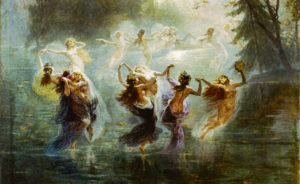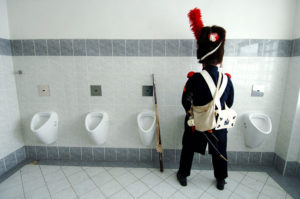Penelope Fitzgerald, until her death in 2000, was, by a country mile, my favourite living author. Her novels offer a view of life the wisdom of which is belied by the physical slenderness of the texts. I love all her novels but The Blue Flower, a fictional representation of the early life of the 18th-century poet-philosopher Novalis, may be her finest.
Few today have heard of Novalis, the pen name of Friedrich Freiherr von Hardenberg. This is a shame for he was an important figure in the developing Romantic tradition and explored in his work the many-faceted dimensions of reality.
The novel’s epigram is a quote from Novalis — Novels arise out of the shortcomings of history — which hints at the nowadays common failure to distinguish realism from naturalism, two conditions which sound alike but are non-identical. The latter is an attempt to delineate life as we live it, while the former attempts something far more inclusive and may explore a less quotidian view of the nature of being. The novels of Sally Rooney are naturalistic, while Fitzgerald’s are realistic; that is to say they explore intangible states that for all their impalpable quality none the less reflect authentic, if less apparent, aspects of real life.
The title of Fitzgerald’s novel is taken from another work of fiction, the mysterious and fragmentary story, The Blue Flower — which became Heinrich von Ofterdingen and the real-life Novalis never completed. Fitzgerald plays with this, stealing the title of her hero’s story and in some sense finishing it without, in a characteristic stroke of genius, finishing either the story of his life or his own fictional creation. This is an example of art reflecting quotidian life but allowing glimpses of something stranger and more impalpable: Fitzgerald transports us to the half-completed life that was Novalis’s (he died aged only 28) and his half-completed work. Her highly individual style — allusive and elusive, fragmentary, dryly humorous — allows the form of her fiction to reflect her own shadowy vision of her hero’s shadowy intimation of reality’s multidimensional, protean nature.
Fritz recounts his fragmentary tale twice, first to his friend Karoline. As in his original story, a stranger arrives out of the dark and poses a question both to the young man, who we guess will become Novalis, and to those who hear the story; and also, of course, to us, the readers. We, the readers, are never vouchsafed the question, but we assume it is one Fritz asks Karoline: “What is the meaning of the blue flower?” She cannot answer; she remains in the dark. In fact, we are all left somewhat in the dark about the meaning of the story, but for Novalis the dark was not a condition of obscurity but a highly generative state. In the Fitzgerald tale, taken from his own, Novalis describes how: “It is as if until now I had been dreaming, or as if sleep had carried me into another world”.
The second time the tale is told is to Sophie, the unremarkable 12-year-old with a double chin with whom, for no rational or discernible reason, Fritz falls in love, leaving Karoline, the woman whose empathy and intelligence by rights should have won his heart, to a life of lonely spinsterhood. But there are no “by rights” in a Fitzgerald novel. Of all contemporary novelists she best understood the antinomianism of the human heart.
A funny and poignant example of one of the important strands in the book, the generative power of absence and nothingness, occurs between Karoline and Hardenberg. As we the readers know, she is in love with him — and he, manifesting one of the many blanks that the book celebrates, is obdurately insensitive to this. “I see,” he says, when he comes to tell her that Sophie is his “heart’s heart” and she, aghast at his choice, demurs: “there is one thing, the most important of all, unfortunately, you don’t grasp, the nature of desire between a man and a woman.” Stung into a kind of semi-revelation, Karoline retorts: “Not everyone can speak about what they suffer. Some are separated from the only one they love but are obliged to remain silent.”
Fritz radically, comically, misconstrues this by at once envisaging a fantasy lover for Karoline and capturing his non-existence in some dubious verse. So that Karoline’s “lover” becomes a double fixture — he exists in the mind of Hardenberg but also in his verse — and so becomes a genuine prop for Karoline’s pride when she has to bear the fact that the man she loves with all her heart loves not her but the very ordinary — irritating even — Sophie.
Out of a gap in understanding, the unreal has been bodied forth through Fritz’s energetic imagination and given objective form in his art. So we are left asking: what kind of reality has this figure? Is it so different, the novel implicitly asks, from Fritz’s passion for the unremarkable Sophie, who nonetheless becomes his lode star, his “philosophie”? Does love, in fact, require an object at all, worthy or otherwise? Or is the fact of love itself enough? It is Sophie’s very blankness out of which the extraordinary love which Hardenberg feels for her is conceived, although in human terms Karoline is clearly a better match. But it is precisely Sophie’s nothingness, her mind “empty as a new jug”, which summons the love.
Before he reads Karoline the blue flower fragment, Fritzl tells her: “there is something else I have written and which I want to read you while I still have time… It will not truly exist till you have heard it.” This is another aspect of the question, for which no answers are supplied, of what makes for the “real”. If it is not quite the case that something has no real existence until we apprehend it, it is suggested both by Hardenberg, and his author, that our human apprehension has a seminal role in creating reality; that reality is, it turns out, a co-operative enterprise in which, if we are to live truly, we must be involved.
The significance of the blue flower evolves in the repeated renderings of the story, in the way that the image of a rose evolves in “a rose is a rose is a rose”. Fritz’s young brother, known as the Bernhard, surreptitiously reads the story and we are told afterwards that for “some time” he had recognised the “meaning” of the blue flower, just as the doctor, who attends Sophie in her mortal sickness, would also, we are told, have understood its meaning had he been introduced to the tale. It becomes apparent that Sophie’s life, despite a harrowing operation undertaken without anaesthetics, will be curtailed by TB and we learn in an elliptical Afterword that the Bernhard drowns. The flower we begin to apprehend is our mortality, but paradoxically it becomes, at the same time, the fragile breath of life airing the series of turns, blank walls, cul-de-sacs and twists of fate which make up the novel’s loose and beguiling narrative.
Much of the texture of that narrative comes from its humour. The Bernhard complains to his elder sister about the latest addition to the Hardenberg family: “There are now two younger than myself. It will be hard for me to attract sufficient attention.” “But you love little Christoph,” said Sidonie patiently. “On the whole I hate little Christoph,” the Bernhard replies.
The mine of wit and intelligence in this slight-seeming book is as wide and deep as the Saxon salt mines for which the young Fritz becomes the unlikely overseer. But for me its peculiar virtue lies in how, without being in the slightest bit solemn or portentous, it conveys Novalis’s intimation that in this world there is no barrier between the seen and the unseen. The question of the meaning of the blue flower is never openly answered. But when the story is told for the second time, Hardenberg suggests: “If a story begins with finding, it must end in searching.” And it’s this sense of an unfolding universe, in which we live with always unanswered, perhaps unanswerable, questions that perfuses the book.
At some point, Hardenberg reflects: “When we catch sight of certain human figures and faces, especially certain eyes, expressions, movements, when we hear certain words, when we read certain passages, thoughts take on the meaning of laws… a view of life true to itself without self-estrangement.” In these increasingly fractured and fractious times, we need to be reminded that the world may be a larger, stranger, like the blue flower both fragile yet enduring, and so ultimately a more numinous place than our limited reason comprehends, but that it is still possible, after all, to have “a view of life true to itself without self-estrangement”.
***
Salley Vickers’s latest novel, “The Gardener”, Penguin, is out in paperback
Disclaimer
Some of the posts we share are controversial and we do not necessarily agree with them in the whole extend. Sometimes we agree with the content or part of it but we do not agree with the narration or language. Nevertheless we find them somehow interesting, valuable and/or informative or we share them, because we strongly believe in freedom of speech, free press and journalism. We strongly encourage you to have a critical approach to all the content, do your own research and analysis to build your own opinion.
We would be glad to have your feedback.
Source: UnHerd Read the original article here: https://unherd.com/




